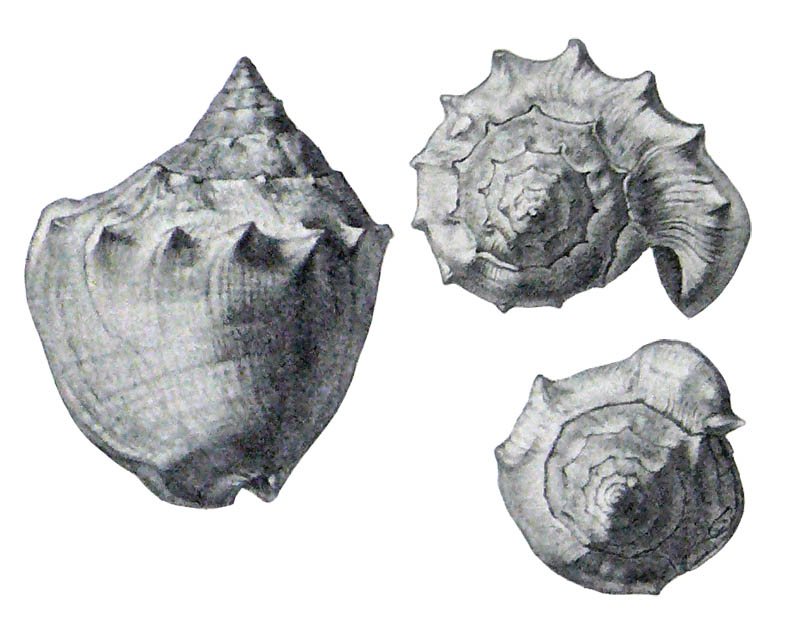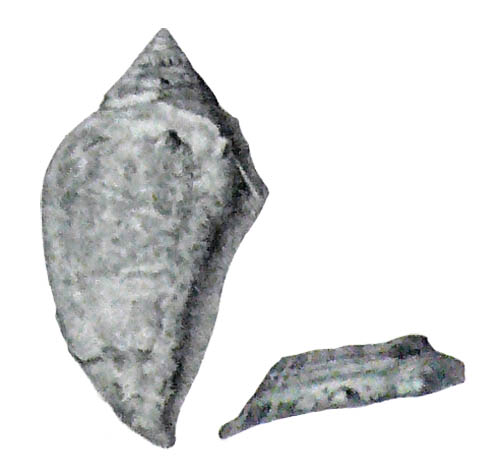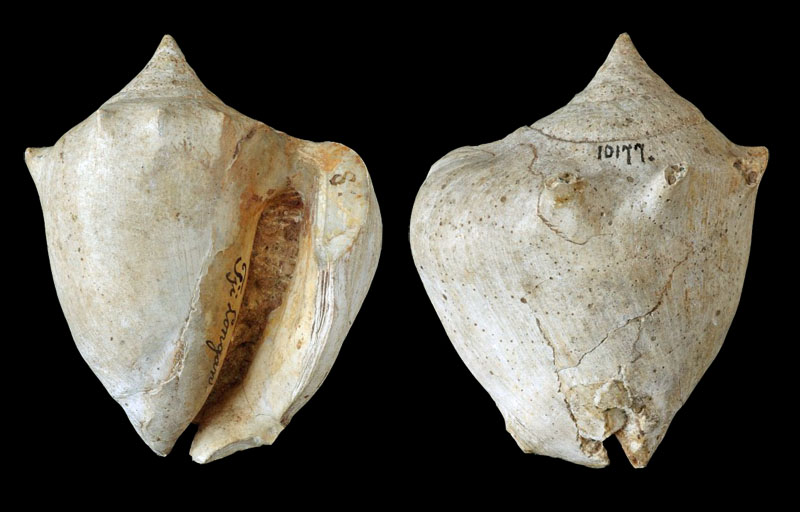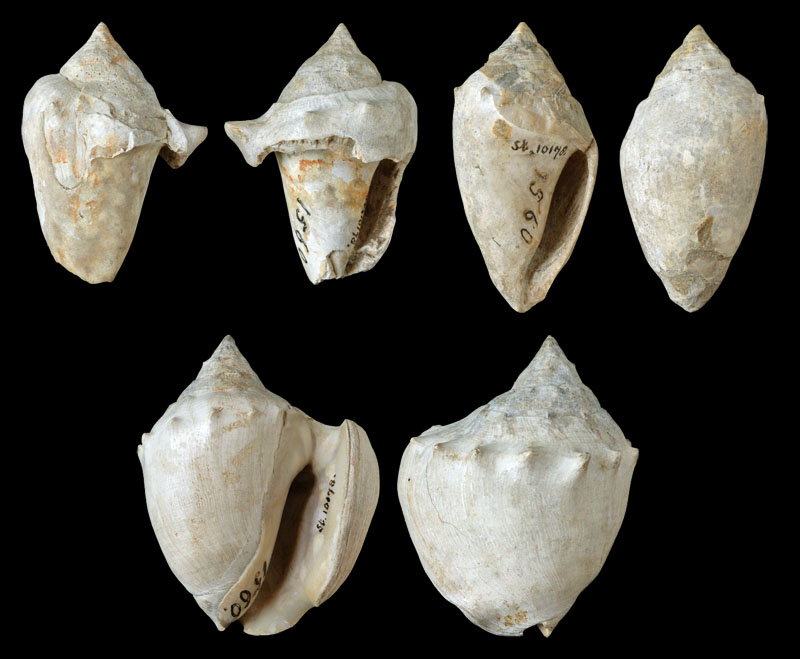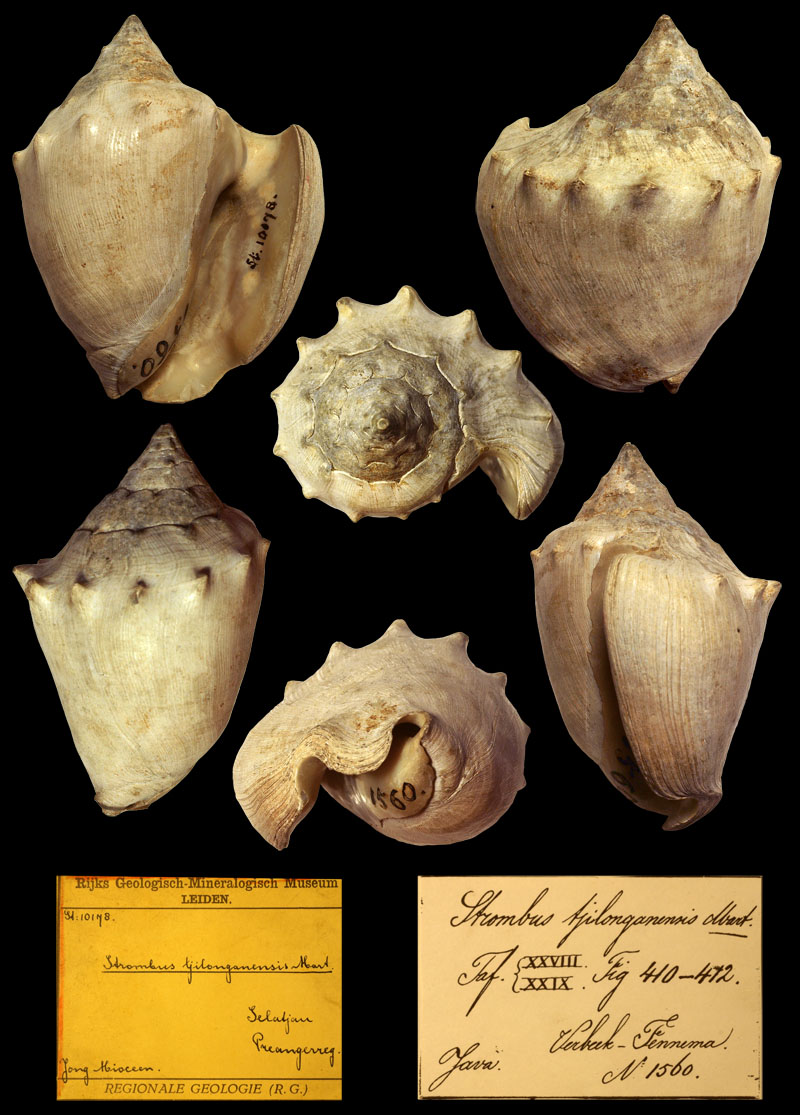|
edit SideBar
|
Species / Strombus Tjilonganensis
- Strombus tjilonganensis Martin, 1899
Original Description of Strombus (s.str.) tjilonganensis by Martin, 1899, p. 177:
- "Die Art ist früher irrthümlich zu dem derzeit noch sehr unvollständig bekannten Str. inflatus Mart. (Tertsch. pag. 48, tab. 9, fig. 3) gezogen worden; doch wurde sie am angeführten Orte ausführlich und gesondert charakterisiert, so dass ich im wesentlichen auf die oben citirte Beschreibung verweisen kann. Es möge derselben auf Grund des jetzt vorliegenden Materials nur noch Folgendes hinzugefügt werden. Die Jugendform ist länglich, zugespitzt-eiförmig bis spindelartig; der stumpfe Kiel, den die Spindel erwachsener Schalen im Innern besitzt, ist bei ihr noch nicht vorhanden. Das Embryonalende ist unbekannt, und die ältesten Mittelwindungen sind bei allen Exemplaren abgerieben; doch bemerkt man nahe der Spitze auf den Umgängen Querrippen, welche nut den hinteren Abschnitt der Windungen frei lassen, so dass sich hier längs der Naht eine rinnenartige Vertiefung ausbildet. Mit dem Anwachsen der Schale gehen die Rippen in Knoten über, welche die vordere Naht begleiten und nach hinten anfangs noch durch eine deutliche Spiralfurche begrenzt sind. Dazu gesellt sich am älteren Gehäuseteile eine Reihe deutlicher Mundwülste. An einem Exemplare zeigt die Schlusswindung nahe der Mundöffnung statt der gewöhnlich vorhandenen, spitzen Knoten einen breiten, hinten abgeflachten Höcker. Die Länge des grössten Exemplares betrögt 66 mm."
Locus typicus: "Selatjau, am Tji Longan"; ‘Ufer des Tji Longan in den Preanger-Regentschaften’ (Martin, 1899); Ci Longgan, West Java Province, Java Island, Indonesia
Stratum typicum: upper Miocene
Comment Martin, 1899, p. 178:
- "Von dem nahe verwandten Str. Herklotsi Mart. (vgl. unten) unterscheidet sich diese Art durch ihr höheres Gewinde und die mehr eiförmige Gestalt, welche namentlich in der starken Zurundung des linken Seitenrandes der Schlusswindung zum Ausdrucke gelangt. Trotzdem kann die Trennung beider Formen bei Bruchstücken Schwierigkeiten verursachen. Gleich den früher beschriebenen stammen auch die mir jetzt vorliegenden 3 Stücke der Verbeek'schen Sammlung von Selatjau, am Tji Longan."
Strombus tjilonganensis Martin, 1899, pl. XXVIII, fig. 410, 410a, 411
Strombus tjilonganensis Martin, 1899, pl. XXVIII, fig. 412, 412a
Strombus tjilonganensis in Martin 1899; Syntype; Strombus inflatus in Martin 1879; Syntype; upper Miocene, Ci Longgan, West Java Province, Java Island, Indonesia; 65 mm; in Leloux & Wesselingh, 2009; Coll. Naturalis no. RGM 10177a; Copyright Naturalis
Strombus tjilonganensis Martin, 1899; Syntypes; upper Miocene, Ci Longgan, West Java Province, Java Island, Indonesia; 46 mm, 51 mm and 56 mm; in Leloux & Wesselingh, 2009; Coll. Naturalis nos. RGM 10178a, 10178b and 10178c; Copyright Naturalis
Strombus tjilonganensis Martin, 1899; Syntype; upper Miocene; Ci Longgan, West Java Province, Java Island, Indonesia; 56 mm; Coll. Naturalis no. RGM 10178c; Copyright Naturalis
History and Synonymy
1970
Description of Strombus (Laevistrombus?) tjilonganensis by Iwasaki, 1970, p. 215:
- "Five specimens are examined. Shell is strombiform with very thick test. Six spires are observable in two comparatively well preserved specimens. Base of shell is slightly arcuated. Aperture is compressed laterally. Outer lip is flared but not so prominent as those of Lambis and Eustrombus. Test of outer lip is thickened extraordinally. Striations are not present on inner surface of the outer lip. Stromboidal notch exists near adapical end of the outerlip. Anterior siphonal canal bents obtusely. Each whorl has nine to 11 remarkable tubercles on shoulder of shell surface. Color pattern is not preserved. The present species is most likely to be included in subgenus Laevistrombus or Labiostrombus, because of its similar shell morphology. Medium sized shell, row of tubercles on shoulder and simple outer lip characterize this species, and are identical with those of Strombus tjilonganensis MARTIN, a fossil species described from Java (Text-fig. 3). Other morphological , characters appeared in the original description coincide fairly well with those of the Philippine specimens. There are no morphologically comparable recent species living in the southeast Asia. Mode of volutions observed in axial section of this species resembles that seen in S. isabella LAMARCK (Text-fig. 4). Measurements in mm.- A; 42ca (shell height), 35:0 (apertural height), 31.5 (maximum. diameter). B; 39.0, 31.5, 26.5. C; 35ca, 27.5, 25.5. D; 37.0, 29.5, 25ca. E; 35ca, 29.0, 22ca."
1972
Description of Strombus (Tricornis) sp. A by Ladd, 1972, p. 58:
- "Incomplete molds of a large strombid that has prominent widely spaced axial knobs on the body whorl were collected from the Alifan Limestone at three localities on Guam and from a comparable horizon in Palau. All the specimens are internal molds, some of them are distorted by compression, but they probably represent the same species. The figured specimen from Guam, USNM 648460, has an apical angle of about 70°; its inner lip is broadly inflated near its base; the specimen measures - length (incomplete) 126 mm, diameter 98 mm. The species does not appear to be closely related to any living Strombus. Superficially the specimens resemble S. tjilonganensis Martin described from the Miocene of Java (Martin, 1899, p. 177, pl. 28, figs. 410, 411, pl. 29, fig. 412). The fossils from Guam and Palau are much larger than any of the shells assigned to S. tjilonganensis, but the absence of the shell material on the Guam and Palau specimens makes detailed comparison impossible. Occurrence. - USGS locs. 20630, 20722, 20740, and 21592 (figured specimen) on Guam; all from Alifan Limestone of late Miocene and Pliocene age (Tertiary g and h). Palau specimen from USGS loc. 18310 at base of Palau Limestone on southwest point of Nardueis Island, off southeast coast of Babelthuap; age, late Miocene (Tertiary g)."
References
- Iwasaki, Y. 1970. 561. A Miocene Molluscan Fauna in the Philippines; Trans. Proc. Palaeont. Soc. Japan, N.S., No. 77, pp. 205-228, pl. 23, Fulltext
- Ladd, 1872
- Martin, K. 1899–1906. Die Fossilien von Java auf Grund einer Sammlung von Dr. R. D. M. Verbeek. Sammlungen des geologischen Reichsmuseums Leiden (Neue Folge) 1: 1899: Ocinebra—Telescopium: 133–220, 1905: Modulus—Delphinula: 221–281, 1906: Nachtrag zu den Gastropoden: 281–325, Fulltext
|

